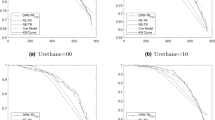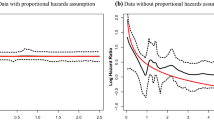Abstract
We propose a mixture model that combines a discrete-time survival model for analyzing the correlated times between recurrent events, e.g. births, with a logistic regression model for the probability of never experiencing the event of interest, i.e., being a long-term survivor. The proposed survival model incorporates both observed and unobserved heterogeneity in the probability of experiencing the event of interest. We use Gibbs sampling for the fitting of such mixture models, which leads to a computationally intensive solution to the problem of fitting survival models for multiple event time data with long-term survivors. We illustrate our Bayesian approach through an analysis of Hutterite birth histories.
Similar content being viewed by others
References
Allison PD (1992) Discrete-time methods for the analysis of event histories. In: Leinhardt S (ed.) Sociological Methodology 1982. Jossey-Bass, San Francisco, pp. 61–98
Allison PD (1987) Introducing a disturbance into logit and probit regression models. Sociological Methods and Research15, 335–374
Box GEP, Tiao GC (1973) Bayesian inference in statistical analysis. Addison-Wesley, New York
Casella G, George El (1992) Explaining the Gibbs sampler. The American Statistician46, 167–174
Cox DR, Oakes D (1984) Analysis of survival data. Chapman and Hall, London
Farewell VT (1982) The use of mixture models for the analysis of survival data with long-term survivors. Biometrics38, 1041–1046
Gelfand AE, Smith AFM (1990) Sampling based approaches to calculating marginal densities. Journal of the American Statistical Association,85, 398–409
Geyer CJ (1992) Practical Markov chain Monte Carlo (with discussion). Statistical Science7, 473–511
Heckman J, Walker J (1990) Estimating fecundability from data on waiting times to first conception. Journal of the American Statistical Association85, 283–294
Hostetler JA (1974) Hutterite society. The John Hopkins University Press, Baltimore
Larsen U, Vaupel JW (1993) Hutterite fecundability by age and parity: strategies for frailty modeling of event histories. Demography30, 81–102
Li L, Choe MK (1997) A mixture model for duration data: analysis of second births in China. Demography34, 189–197
Maller R, Zhou X (1996) Survival analysis with long-term survivors. Wiley, Chichester
Meng XL, Rubin DB (1991) Using EM to obtain asymptotic variance-covariance matrices: the SEM algorithm. Journal of the American Statistical Association86, 899–909
Redner RA, Walker HF (1984) Mixture densities, maximum likelihood and the EM algorithm. SIAM Review26, 195–239
Prevost AT (1997) Multilevel modelling of child mortality: Gibbs sampling versus other approaches. Unpublished Ph.D. thesis University of Southampton, UK
Sheps MC (1965) An analysis of reproductive patterns in an American isolate. Population Studies19, 65–80
Sheps MC, Menken JA (1963) Mathematical models of conception and birth. University of Chicago Press, Chicago
Smith AFM, Roberts GO (1993) Bayesian computation via the Gibbs sampler and related Markov chain Monte Carlo methods (with discussion). Journal of the Royal Statistical Society, Series B55, 3–23
Thomas A, Spiegelhalter DJ, Gilks WR (1992) BUGS: a program to perform Bayesian inference using Gibbs sampling. In: Bernardo JM, Berger JO, Dawid AP, Smith AFM (eds.) Bayesian statistics 4. Clarendon Press, Oxford, pp. 837–842
Yamaguchi K (1992) Accelerated failure-time regression models with a regression model of surviving fraction: an application to the analysis of ‘permànent employment’ in Japan. Journal of the American Statistical Association87, 284–292
Yamaguchi K, Ferguson LR (1995) The stopping and spacing of child births and their birth-history predictors: rational-choice theory and event history analysis. American Sociological Review60, 272–298
Wang D, Murphy M (1998) Use of a mixture model for the analysis of contraceptive-use duration among long-term users, Journal of Applied Statistics25, 319–332
Author information
Authors and Affiliations
Rights and permissions
About this article
Cite this article
McDonald, J.W., Rosina, A. Mixture modelling of recurrent event times with long-term survivors: Analysis of Hutterite birth intervals. Statistical Methods & Applications 10, 257–272 (2001). https://doi.org/10.1007/BF02511651
Issue Date:
DOI: https://doi.org/10.1007/BF02511651




